By Eureka Henrich, CArchipelago Project Researcher
I grew up in Sydney, conscious as any Australian school child of my city’s 18th century origins as a penal colony. At primary school we learned the stories through song, such as ‘Bound for Botany Bay’ (narrated by forlorn transportee who warns those back home in England not to follow in his criminal footsteps). While I don’t remember all the verses, the catchy chorus stuck fast and I can still hum it today. The arrival of 11 ships of convicts, livestock and officers in January 1788 became a date ingrained into my summer holidays – there was the long wait for Christmas, followed by Boxing Day, New Years, and finally Australia Day, January 26, signalling one last public holiday before heading back to school for a new academic year. It was a day for barbeques and beach visits, or a trip to the zoo. Heading to see the animals would involve a journey across the harbour on one of Sydney’s ferries – the Supply, the Friendship and the Charlotte, they bore some of the names of the original 11 vessels of the First Fleet. And as a teenager I attended high school in a building designed by the convict architect Francis Greenway, and built by convict labour. Its original function was to house the Governor’s horses and carriages. By the twentieth century, the sounds echoing within were not of hooves but horns, as it had become the Sydney Conservatorium of Music.
These manifestations of convict heritage are indicative of my generation. By the 1980s, fuelled by a resurgence in family history, an embrace of the ‘new nationalism’ and the opening of state archives, Australians were discovering their convict ancestors anew – no longer shameful skeletons best kept in the closet, they could now be regarded as a badge of honour, or even as the founders of the nation (hence the naming of the iconic ferries). During the official celebration of the Bicentenary of British colonisation, convicts were even cast as the first migrants, credited with kicking off the ‘nation of immigrants’ in a similar fashion to the Mayflower pilgrims in America. But the government-choreographed 1988 celebrations were also marked by a profound collective unease. Could our convict ancestors be founders, as well as invaders? The gulf between stories of settler survival against the odds, and the mounting historical evidence of the violent dispossession that was part of that ‘survival’, could no longer be ignored or glossed over. As a result, the History I leant at school was vastly different to the previous generation of Australian schoolchildren. While explorers and empires still held sway, they were joined by other historical actors – workers, women, migrants and Indigenous Australians, each with a compelling claim to belonging in the story of the nation.
Since I began to research representations of transportation at convict heritage sites in Australia for the CArchipelago project, I’ve gained a new appreciation of the heritage I unknowingly soaked up as a child. As an Australian without direct ancestral links to convicts, I wonder whether I would feel differently if the connections were familial, as well as cultural. And what about international visitors to Australia – what kind of convict heritage do they encounter? And how has it changed over recent years? Heritage – or ‘things worth saving’, in David Lowenthal’s apt words – can encompass the tangible, such as places, and the intangible, such as songs; the visible, such as buildings, and the hidden, such as archaeological remains. But most importantly, the designation of ‘heritage’ significance infers an opinion, a ‘worth’, a judgement on the past and a construction of that past for a present audience or consumer. These constructions are constantly changing, making the study of convict heritage sites a fascinating window onto the ways that Australians have related to their carceral past and presented that past to others. And now is a particularly interesting time to conduct this research, as eleven of Australia’s historic places were in 2010 recognised by UNESCO as being of ‘outstanding universal value’. Encompassing colonial homesteads, probation stations, barracks, penitentiaries, female factories and coal mines, across New South Wales, Western Australia and Tasmania, these places now form the Australian Convict Sites World Heritage Property. I have been studying these sites and others from afar, combing through the writings of historians, archaeologists, tourism researchers and heritage practitioners to gain an overview of the main themes and debates in the field. A recent trip to Sydney afforded me the opportunity to experience two of these sites in person: Hyde Park Barracks, and the Old Great North Road on the Hawkesbury River. Both sites are included in the World Heritage listing, and both date from a similar period in the history of the colony, however they represent very different ‘experiences’ for a visitor, as I discovered.
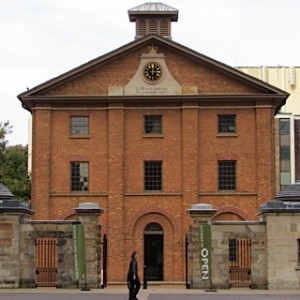
The façade of Hyde Park Barracks on Macquarie Street, Sydney. Photo: Eureka Henrich
First off the bat was Hyde Park Barracks Museum. The Barracks are another of Sydney’s now-iconic buildings designed by Francis Greenway for Governor Macquarie. The men and boys who built the Barracks were later housed in them, and during daylight hours they were sent out to work in government gangs. Importantly, before the Barracks opened in June 1819 to better regulate the convict workforce, convicts lived either with the masters they were assigned to or in homes they had built themselves – the popular image of Sydney as a gaol-town populated by convicts in chains is far from the truth. The impression of colonial Sydney that emerges from the displays at Hyde Park Barracks Museum is one of adaptation, rather than incarceration. About 50,000 convicts passed through the building before transportation came to an end in New South Wales in 1840, and the rooms were then used for a multitude of purposes – first to house Irish girls orphaned through the famine, then as a reception centre for single female emigrants, before accommodating elderly and destitute women and finally being taken over as government offices. The Barracks might have gone the way of much of Australia’s convict heritage sites and been demolished, built-over and forgotten. But fortunately archaeologists were able to make a case for its strong significance, and the building and its surrounds were restored and opened as a museum of social history in 1984. Management passed from the Museum of Applied Arts and Sciences to the Historic Houses Trust (now Sydney Living Museums) in 1990, and a refurbished suite of exhibitions were opened. Since then Hyde Park Barracks has been a ‘museum of itself’, telling the story of a city built on the labour of convicts, and the continual arrival of migrants.
Work is a major theme of the current exhibition, Convict Sydney, which features wide array of tools displayed impressively across one wall – carpentry, coopering, leathermaking and blacksmithing involve a cornucopia of objects curious to the modern eye. But what struck me most in my visit was the imaginative use of large-scale images – across walls, underfoot, and in unexpected formats, such as an installation of a panorama of Sydney painted in 1820 by Major James Taylor. Anyone who has walked part of the Sydney harbour foreshore would find the scenes captured within the panorama captivating – North Head, the Rocks, Bennelong Point, these places painted for the entertainment of curious Britons back home now hold new fascination as the warped ‘before’ in a mental ‘before and after’ game (the painter has chosen a rosy representation and the resulting inaccuracies are noted in the exhibition text). The tiny detail of Taylor’s panorama is echoed in the adjacent gallery by an artwork commissioned especially for the exhibition. Covering two entire walls of the room, the giant image tells a visual tale of crime, punishment and transportation of convicts to Australia, ending with arrival in the colony.[1] Although the image is contemporary, and in that sense ‘fictional’, it is informed by historical scholarship and the rigorous attention to detail and social interaction (such as a couple exchanging ‘love tokens’ before parting in England) enlivens an otherwise foreign and opaque experience of poverty, desperation and forced migration. After such a lavish display, the almost empty top floor of the museum comes as a shock. Here, curators have reconstructed the hammocks in which convicts once slept, letting visitors’ imaginations fill in the picture.
Convict hammocks at Hyde Park Barracks Museum. Photo: Eureka Henrich
One of the ironies of the global history of transportation is the natural beauty of the sites that were chosen as places of punishment. Australia has many such examples, from Norfolk Island to Port Arthur. A lesser-known but no-less beautiful site is the Old Great North Road, now part of Dharug National Park just over an hour’s drive north-west of Sydney. Between 1826 and 1836 various road gangs of convicts, some in leg-irons, toiled in bushland near the Hawkesbury River to build a road connecting the burgeoning town of Sydney to the fertile farming lands in the Hunter Valley. By blasting away natural sandstone and dividing it in into large blocks with pick axes, the 700-odd men constructed a massive 264 kilometres of road, 47 kilometres of which remain intact today. Two sections of the road – the abandoned Finch’s Line and Devine’s Hill, are part of the World Heritage listing, and together they make an easy 9 kilometre bushwalk, taking between 3 to 4 hours.
Entrance to The Old Great North Road, Dharug National Park. Photo: Eureka Henrich
My teenage brother and I made a daytrip of the walk, arriving by car via the sleepy riverside-town of Wiseman’s Ferry. This crossing point over the Hawkesbury was one the road gangs were familiar with, as they relied on the ex-convict landowner and ferryman Solomon Wiseman for their rations and other supplies (readers of Kate Grenville’s popular novel, The Secret River, will recognise Wiseman as the historical figure who provided the inspiration for the character of William Thornhill). A ‘Convict Road Kiosk’ nearby is the only visible indication of the 2010 World Heritage listing – the convicts painted on the shop’s shutter stare out blankly from behind bars. But my tech-savvy brother and I were also armed with a snazzy ‘Convict Road’ app, developed by the NSW National Parks and Wildlife Service in anticipation of increased visitation to the site. Once across the Hawkesbury River the app directed us to the beginning of the walk, and provided a guided tour with short videos along the route. Each stop on the tour offers a choice of videos, either ‘Live the History’ or the ‘Present Day’, so we could decide whether our tour was to be guided by an archaeologist, park ranger and an Aboriginal elder, or actors playing the parts of convict workers, overseers, surveyors and colonial visitors to the road. Both were equally entertaining and enlightening, right down to the accuracy of convicts’ accents (Scottish, Irish, and a thick cockney twang were all represented). Older signage along the route was also useful, pointing out the methods by which road gangs constructed walls, bridges and drainage systems in a feat of engineering, skill and endurance. Some of the characters in the videos are proud of their work despite bemoaning the tragedy of their circumstances (convicts in road gangs had been convicted at least twice, and the punishing work was regarded as the most undesirable in the colony). Other characters, such as the surveyor Heneage Finch, are almost comical in their melancholy, constantly complaining about the terrible conditions, lack of comfort and the laziness of the convicts. These characters have been based in written records, and the language does evoke a bygone era very effectively. I found that after a little while, we preferred to just walk along, stopping to run our fingers over the pick-marks in the stone made by men almost two hundred years ago, or to marvel at the intricate buttresses and culverts that punctuate the neat rows of stones.
Detail of stonework, Old Great North Road. Photo: Eureka Henrich
Keen-eyed walkers will find initials etched into the stone – convict graffiti that has now become precious evidence of disobedience or daring, an act which would have earned many lashes (convicts in the app explain that they were flogged on a Saturday, so they could return to work on Monday following the Sabbath). The app is a great way to engage a young audience and international visitors, and to introduce individuals who were part of the system of convict transportation. But nothing can replace that feeling of ‘being there’, listening to the sounds of the bush all around, the whir of the cicadas and the distinctive call of the whip bird. Small lizards slink over rocks heated by the sun, and the sweat begins to trickle as the heat of the day spreads. As we sat down for our packed lunch on a rocky outcrop, the bend of the river, farmlands, and ferry seemed small compared to the bush behind us. It was far from the scene people usually think of when they hear the term ‘convict heritage’ – nary a barred cell in sight.
View over the Hawkesbury River and Wiseman’s Ferry from the Old Great North Road. Photo: Eureka Henrich
Acknowledgements
My thanks to Carlin de Montfort at Sydney Living Museums for generously showing me around Hyde Park Barracks Museum.
Find out more about Eureka’s work at: https://kcl.academia.edu/EurekaHenrich
[1] See http://sydneylivingmuseums.com.au/stories/convict-sydney

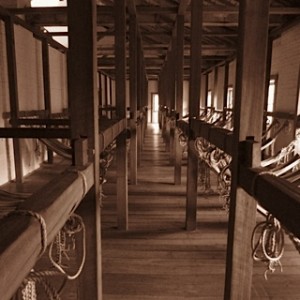
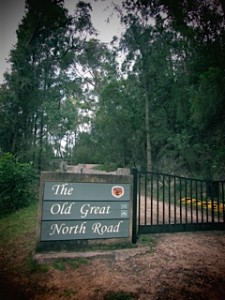
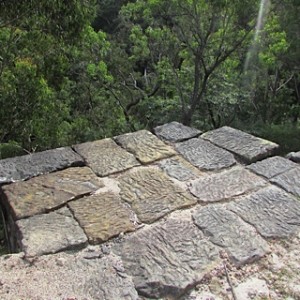
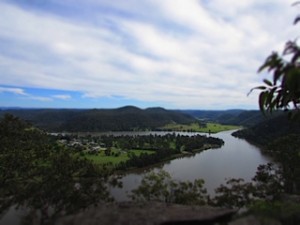

 Subscribe to Clare Anderson's posts
Subscribe to Clare Anderson's posts
[…] as the one we can read in previous posts in this blog – Bermuda and Cape Town, Eureka Henrich on Sydney and Katherine Roscoe on Rottnest Island. However, I repeatedly, and somehow irritatingly, bumped […]